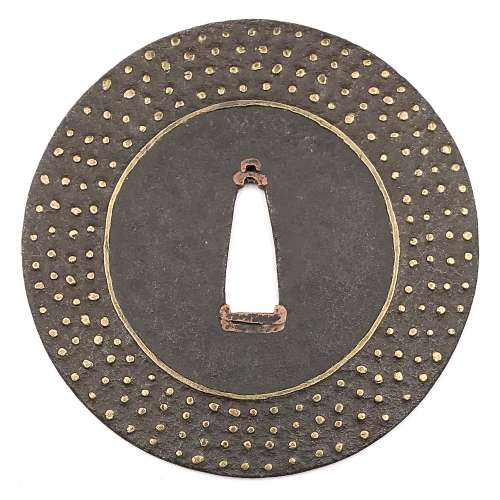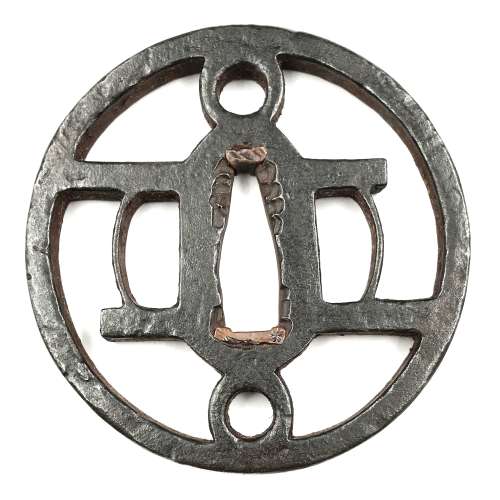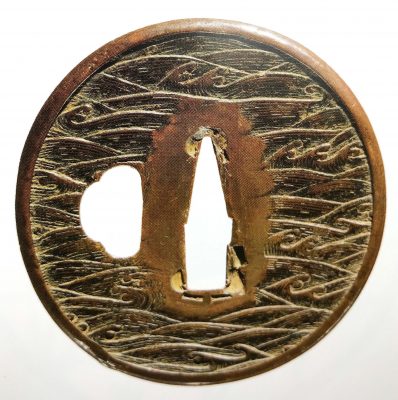
Kokusai Tosogu Kai 5th, 2009, p. 51, № 5-U8: ko-kinko or tachi-kanagushi tsuba.
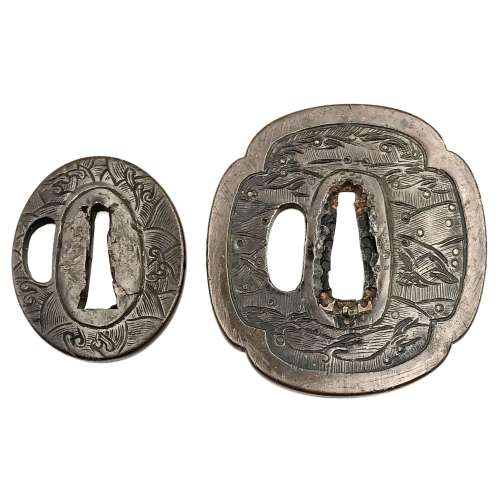

Kokusai Tosogu Kai 5th, 2009, p. 51, № 5-U8: ko-kinko or tachi-kanagushi tsuba.


The Henry D. Rosin Collection №9.

Lundgren Collection №7.

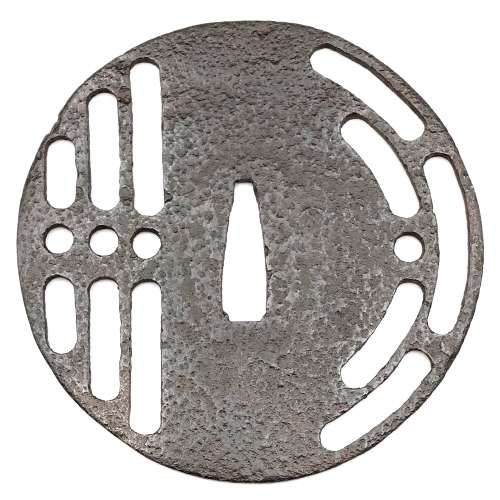
"Traditionally the old iron plate tsuba are classified into Ko Tosho (old sword smith), and Ko Katchushi (old armor maker) styles. It is sometimes difficult to justify attribution of a given tsuba to the Tosho or Katchushi category. Generally guards with raised rims or relatively complex designs tend to be assigned to Katchushi. This is basically a convention we follow out of habit and convenience." [...] "In Token Kai-Shi part six, Articles by Akiyama Kyusaku, Robert Haynes comments: "…from 1300 to 1400 over 150,000 MOUNTED swords were made in Japan for export alone. This means that over four tsuba a day were made for 100 years. This would mean that at least 3000 persons were making nothing but tsuba, let alone all the other fittings needed to complete these swords. With sword smiths, fittings makers and all the other artists need to complete a sword for export, at least 10,000 sword artists were working together, in any one of these hundred years."Another tsuba of similar design, Tōshō school, is illustrated in this collection; see TSU-0319.2015.
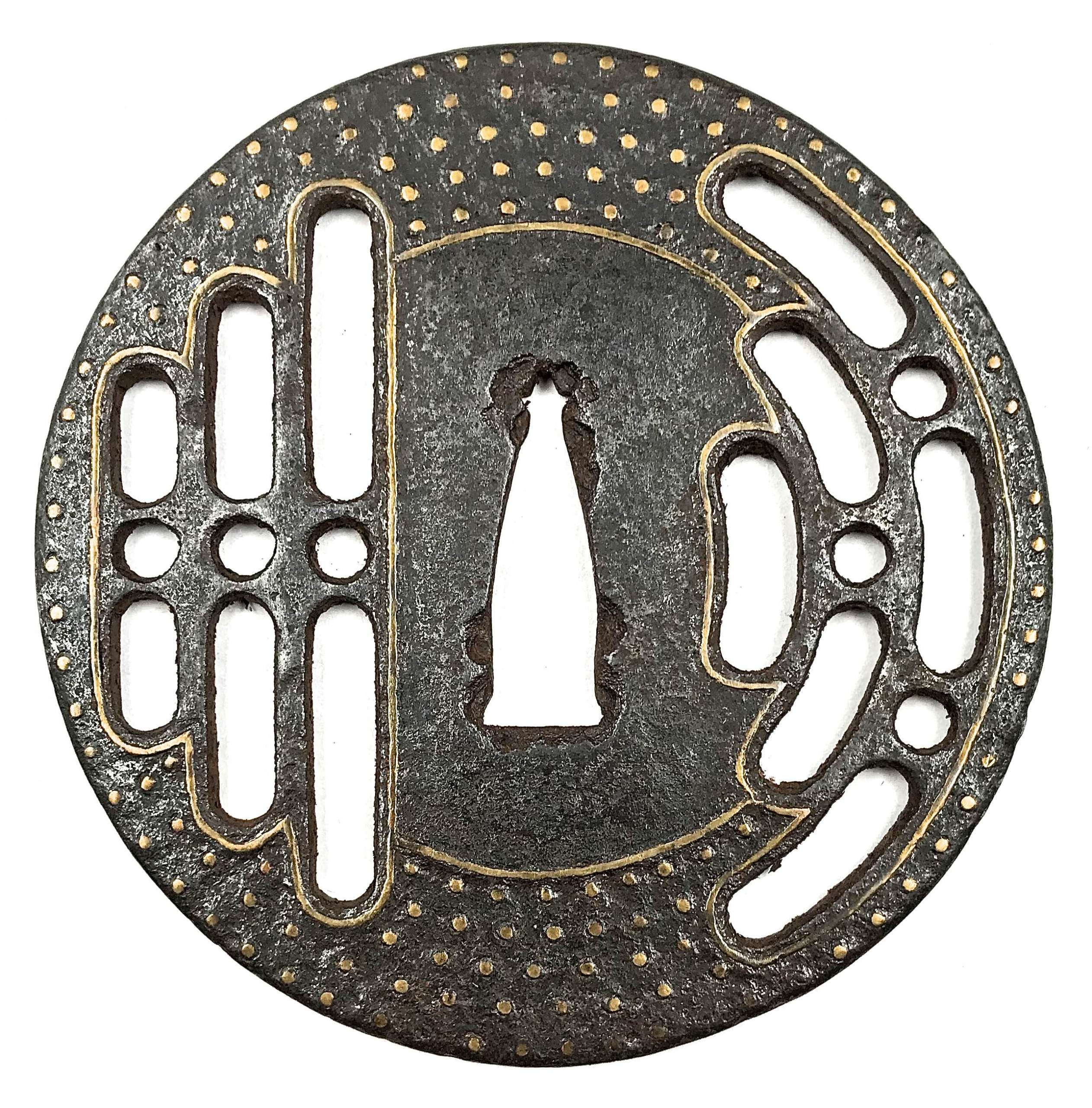 Reference to this design can be found in LIB-1359.2017 Japanese Swords and Tsuba from the Professor A. Z. Freeman and the Phyllis Sharpe Memorial collections, Sotheby's, London, Thursday 10 April 1997; p. 18-19, lot № 37: "A Kamakura-bori Tsuba, Momoyama Period. ...pierced with two large formalised butterflies..."
Reference to this design can be found in LIB-1359.2017 Japanese Swords and Tsuba from the Professor A. Z. Freeman and the Phyllis Sharpe Memorial collections, Sotheby's, London, Thursday 10 April 1997; p. 18-19, lot № 37: "A Kamakura-bori Tsuba, Momoyama Period. ...pierced with two large formalised butterflies..."

A Kamakura-bori tsuba of octagonal form, Momoyama period.
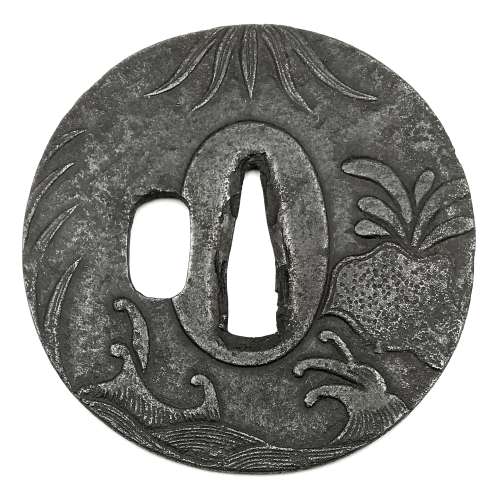

Butterfield & Butterfield, 1979. Sale # 3063, lot № 66.
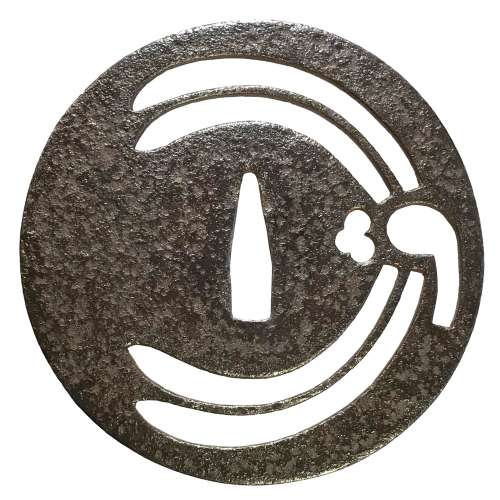
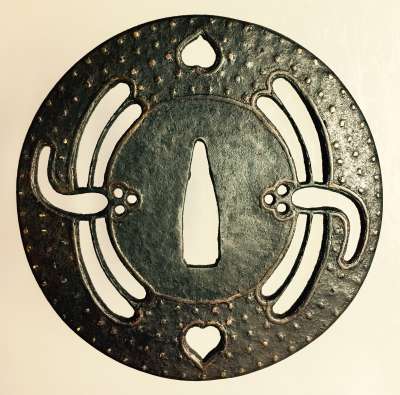
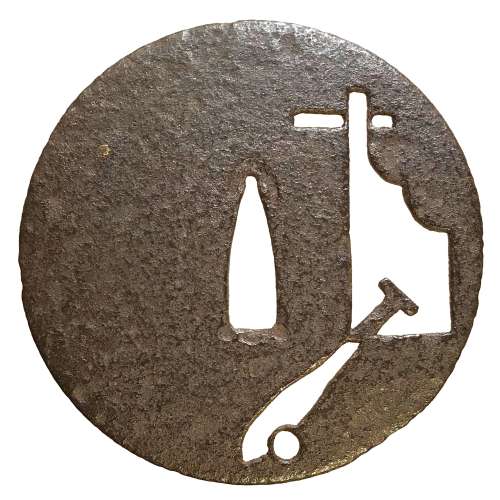
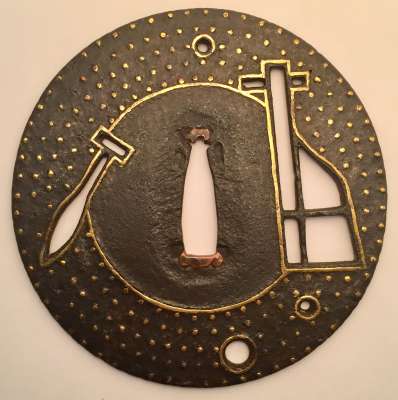


Compton's Collection, Part I, p. 11, №3.
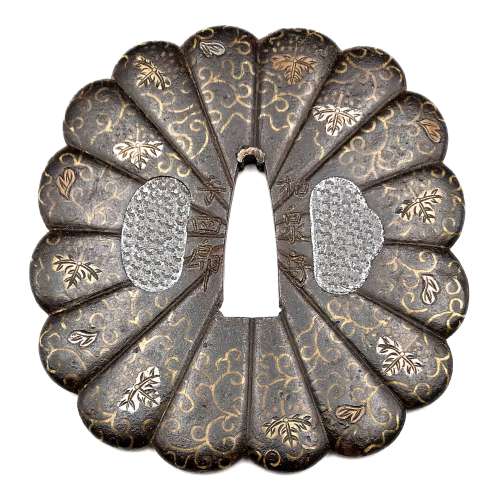
"Early signed example of the work of Koike Naomasa. The kiku shape iron plate is well finished. The flush inlay is brass, for the scroll work on both sides, with the leaves and kiri mon in brass, copper and silver with strong detail carving. Some of the inlay goes almost over the edge, which is goishi gata. The large hitsuana are plugged in lead with starburst kokuin surface design. [...]The face is signed in deep bold kanji: Koike Naomasa; the back is signed: Izumi no Kami, on the right and Yoshiro on the left. There are one or two small pieces of inlay missing. Sold by Sotheby London, Oct. 27, 1981, lot 368. Height = 86 mm, thickness (seppa-dai) = 3.75 mm, (edge) = 4 mm."Another similar example presented at: "Tsuba" by Günter Heckmann, 1995, №T55 — "Designation: Koike Naomasa. Mid Edo, end of the 17th century. Iron, hira-zogan in brass, copper, silver and shakudo, katakiri-bori. Tendrils and leaves. 87.0 x 78.0 x 4.0 mm." Reference: Japanische Schwertzierate by Lumir Jisl, 1967, page. 13. [SV: Actually, his tsuba is signed Izumi no Kami Yoshiro on the back; and Koike Naomasa on the front, exactly as Robert Haynes's tsuba. Dating this tsuba Mid-Edo, 17th century may be considered a misattribution]. More details regarding the Yoshirō tsuba.
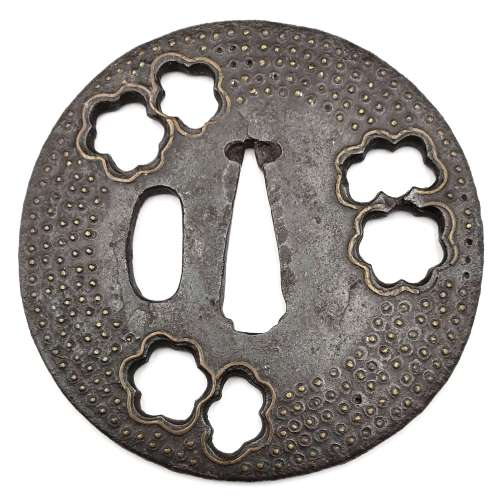
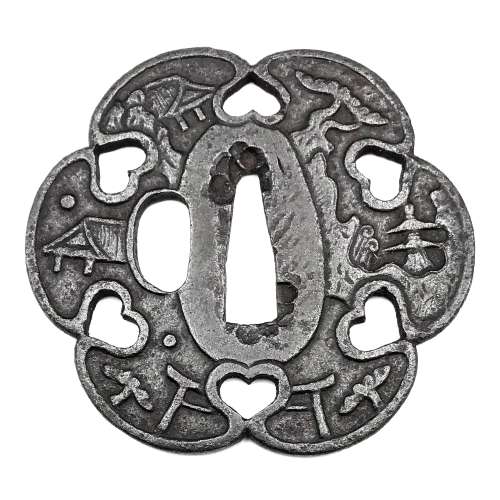

Compton Collection, part II, pp. 14-15, №17: Kamakura-bori tsuba, ca. 1450.

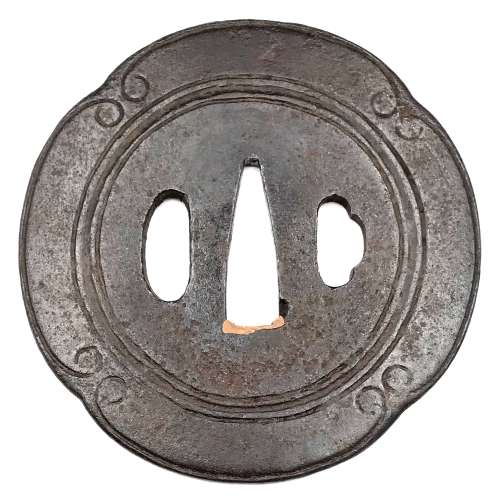
 The description goes: “A kamakurabori type tsuba, Muromachi period, circa 1400. The thin, six-lobed iron plate is carved on each side with a wide groove that follows the shape of the rim, and with six scroll lines and a single thin circular groove. […] The hitsu-ana was added at a later date, circa 1500-1550. Height 8.3 cm, width 8.6 cm, thickness 2.5 mm. The tsuba was initially intended to be mounted on a tachi of the battle type in use from Nambokucho to early Muromachi period (1333-1400)”. Sold at $935.
And another one in Robert E. Haynes Catalog #9 on page 24-25 under №23:
The description goes: “A kamakurabori type tsuba, Muromachi period, circa 1400. The thin, six-lobed iron plate is carved on each side with a wide groove that follows the shape of the rim, and with six scroll lines and a single thin circular groove. […] The hitsu-ana was added at a later date, circa 1500-1550. Height 8.3 cm, width 8.6 cm, thickness 2.5 mm. The tsuba was initially intended to be mounted on a tachi of the battle type in use from Nambokucho to early Muromachi period (1333-1400)”. Sold at $935.
And another one in Robert E. Haynes Catalog #9 on page 24-25 under №23:
 R.E. Haynes description: “Typical later Kamakura-bori style work. This type of plate and carving show the uniform work produced by several schools in the Muromachi period. Some had brass inlay and others were just carved as this one is. The hitsu are later. Ca. 1550. Ht. 8.8 cm, Th. 3.25 mm”. Sold for $175.
R.E. Haynes description: “Typical later Kamakura-bori style work. This type of plate and carving show the uniform work produced by several schools in the Muromachi period. Some had brass inlay and others were just carved as this one is. The hitsu are later. Ca. 1550. Ht. 8.8 cm, Th. 3.25 mm”. Sold for $175.



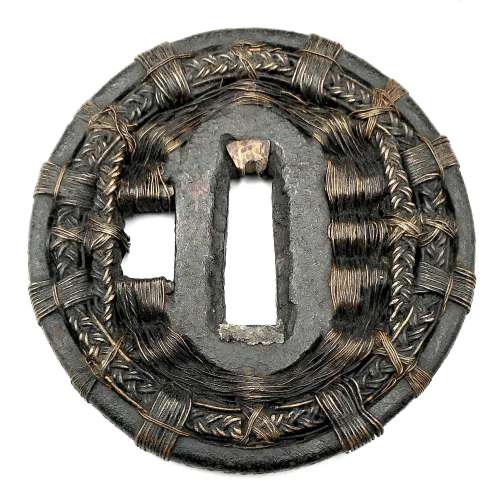

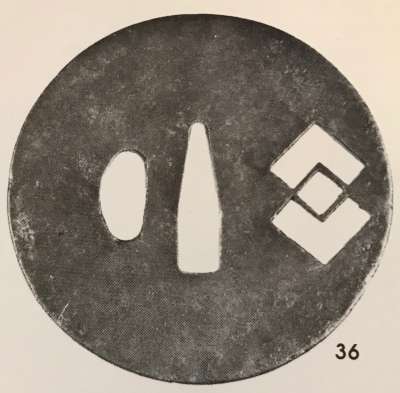
Robert E. Haynes Catalog of April 9-11, 1982, № 36.
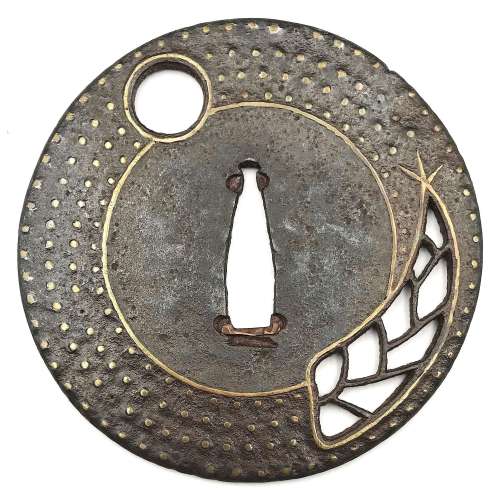
Tears That Brought Bamboo-shoots From the Frozen Earth: Meng Zong Meng Zong lived during the Three Kingdoms Period of China's past. His father died when he was young, and he and his mother struggled to survive. One winter his mother was stricken with a serious illness, and craved some bamboo-shoot broth as medicine. But in the depths of winter, with snow and ice blanketing the ground, where was anyone to find fresh bamboo shoots, shoots that emerge only in the warm months? Nonetheless, Meng Zong, to avoid disappointing his mother, bravely fetched his shovel and went out into the white landscape in search of bamboo shoots. In the thicket he found only frosted leaves and green stalks coated with snowflakes and ice. Look as he might, there were simply no fresh shoots growing in the winter. The thought of his poor mother lying sick on her bed, waiting for bamboo-broth medicine, made his heartache. Uncontrollably, tears began to fall in rivers to the ground beneath the tall, emerald canes. Even now, as his tears flowed down, he kept a light of faith in his heart. If he was truly sincere in his search, perhaps.... Just then Meng Zong nearly tripped and fell over a sharply protruding lump of earth. He quickly knelt down and knocked aside the dirt with his trembling fingers. How uncanny! Underneath his frozen hands he discovered a bed of fresh, tender bamboo shoots! Overjoyed, he gathered up a coatful and carried them back home. The broth that he quickly set stewing in the pot soon cured his mother's illness. The neighbors, hearing the story, exclaimed that it was the strength of his sincere, unselfish, filial resolve that inspired heaven and earth to respond, and to bring up, out of season, the fresh shoots that cured his mother's disease. Before Meng Zong's prayers generated this miracle, it was normally considered impossible for bamboo shoots to grow in the winter. After the nmiracle took place, however, people were able to gather and to eat bamboo shoots all year round. The winter variety that existed hereafter became known as "winter shoots." The villagers were deeply influenced by Meng Zong's courage and devotion. They renamed the spot where the event took place, "Meng Zong's Bamboo Grove". We can now enjoy bamboo sprouts during the winter as well, and as we do so, it is fitting to recollect Meng Zong's outstanding example of filial respect, and reflect on our conduct as sons and daughter of our parents. A verse in his honor says, His teardrops transformed winter at the roots; Up from the ice crept tender bamboo shoots. Instantly, the winter-sprouts matured; Heaven's will: a happy, peaceful world.
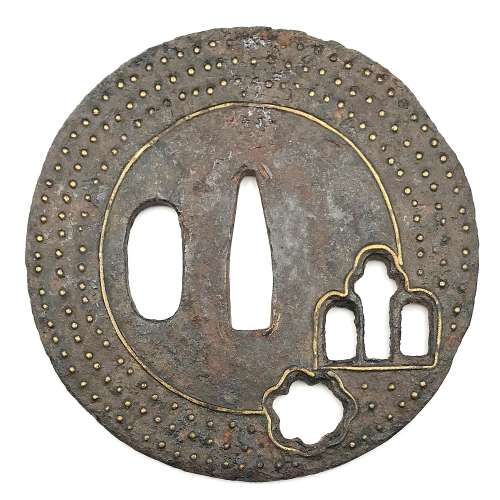
NBTHK certification of 1968: "Kicho". Condition is relatively poor: rust, missing inlay, scratches.
While representation of the snowflake is rather standard, the meaning of the other cut-out design was initially less clear. Similar symbol was found at (1) "Kokusai Tosogu Kai, International Convention & Exhibition, September 24-25, 2005, The Frazier Historical Arms Museum, Louisville, Kentucky, USA"; on page 21 there is a photograph J-6 of a ko-tosho tsuba with "iris theme openwork"; (2) Japanese Swords and Tsuba from the Professor A. Z. Freeman and the Phyllis Sharpe Memorial collections. Sotheby's, London, Thursday 10 April 1997; page 11, lot 6 - a ko-katchushi tsuba of early Muromachi period fith "simple design of stylized iris". In both sources the symbol is explained as 'iris" (kakitsubata).
Freeman and Sharpe collections. Sotheby's, 1997.

Kokusai Tosogu Kai, September 24-25, 2005.
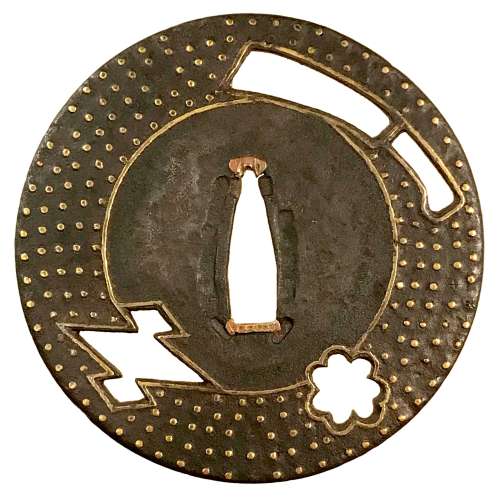
Iron tsuba of round form with design of hatchet, snowflake, and triple diamond in openwork (ko-sukashi), and inlaid with five concentric circles of brass dots (ten-zōgan) and brass inner circular line. Sukashi elements outlined in brass.
Late Muromachi period. Diameter: 82.4 mm; Thickness: 3.0 mm The triple lozenge (or diamond) is similar to the one on TSU-305 from Sasano Collection # 15. Very old motif; as Sasano remarks in his book "...represents the unstable political situation at the time".Kokusai Tosogu Kai 5th International Convention & Exhibition, October 28-30, 2009 at NEZU Museum, Tokyo, Japan, on page 83 provides the following explanation of the triple diamond symbol: "The pine bark is the form of the Diamonds, "Bishi", mon, seen from Nara period, found on cloth stored in the Shoso In, and used primarily by the Takeda family. The form of Bishi mon [similar to ours] is called "Chu Kage Matsukawa Bishi", (Middle Shaded Pine Bark Diamond)."
A combination of hatchet (usually an axe) and a triple diamond (Matsukawabishi) alludes to the Nō play Hachi-no-ki (ref: Iron tsuba. The works of the exhibition "Kurogane no hana", The Japanese Sword Museum, 2014; AND Sasano: Japanese Sword Guard Masterpieces from the Sasano Collection. By Sasano Masayuki. Part One. Published in Japan in 1994.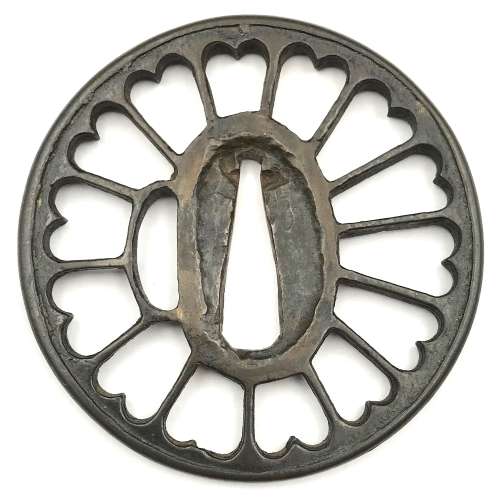
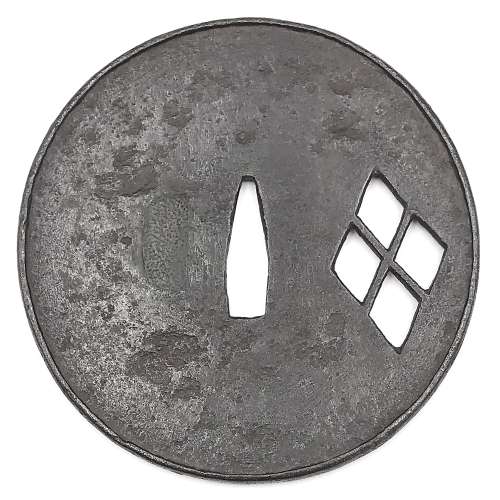
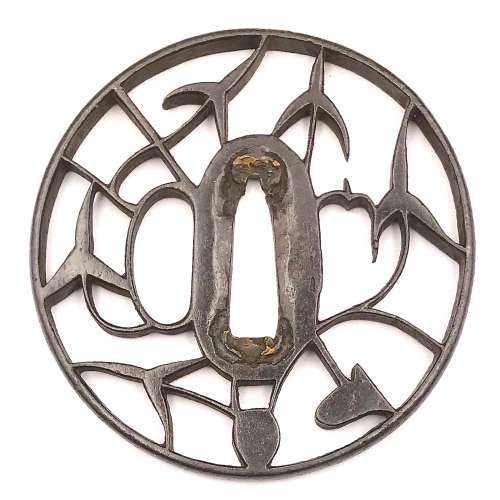
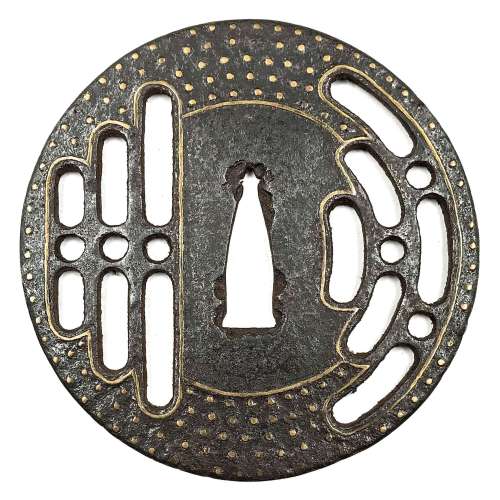
 The design is referenced in LIB-1359.2017 Japanese Swords and Tsuba from the Professor A. Z. Freeman and the Phyllis Sharpe Memorial collections, Sotheby's, London, Thursday, 10 April 1997; p. 18, item 37: "pierced with two large formalised butterflies..."
The design is referenced in LIB-1359.2017 Japanese Swords and Tsuba from the Professor A. Z. Freeman and the Phyllis Sharpe Memorial collections, Sotheby's, London, Thursday, 10 April 1997; p. 18, item 37: "pierced with two large formalised butterflies..."

A Kamakura-bori tsuba of octagonal form, Momoyama period




 The same interpretation of the said heart-like symbol (aoi leaf) is given at Helen C. Gunsaulus. Japanese sword-mounts in the collection of Field Museum. // Publication 216, Anthropological Series, Volume XVI; Chicago, 1923; p. 54: "This mokkō-formed tsuba recalls the aoi form, perforated as it is with the four aoi leaves." It is possible that the "wild boar's eye" theory was developed by later scholars.
The same interpretation of the said heart-like symbol (aoi leaf) is given at Helen C. Gunsaulus. Japanese sword-mounts in the collection of Field Museum. // Publication 216, Anthropological Series, Volume XVI; Chicago, 1923; p. 54: "This mokkō-formed tsuba recalls the aoi form, perforated as it is with the four aoi leaves." It is possible that the "wild boar's eye" theory was developed by later scholars.
 There is also a theory, supported by Graham Gemmell, saying that: “In simple terms Onin works are decorated Ko-Katchushi tsuba. … But, not content with iron alone, they began to decorate it with what was, in the early Muromachi period, a rare and valuable metal, brass. The Onin workers cut the design into the iron, using narrow channels, cast the brass, piece by piece, and then hammered it into the iron plate as though they were putting together a jigsaw. When complete the tsuba would be black lacquered exactly as the plain iron ones had been, the brass shining dully through it in a way that fulfilled the goal of shibui or restrained elegance.” [Tosogu. Treasure of the samurai. Fine Japanese Sword Fittings from The Muromachi to The Meiji Period, by Graham Gemmell. // Sarzi-Amadè Limited, London, 1991. An exhibition held in London from 21st March to 4th April, 1991]. The following illustration from Helen C. Gunsaulus. Japanese sword-mounts in the collection of Field Museum. // Publication 216, Anthropological Series, Volume XVI; Chicago, 1923; pp. 43 supports the idea.
There is also a theory, supported by Graham Gemmell, saying that: “In simple terms Onin works are decorated Ko-Katchushi tsuba. … But, not content with iron alone, they began to decorate it with what was, in the early Muromachi period, a rare and valuable metal, brass. The Onin workers cut the design into the iron, using narrow channels, cast the brass, piece by piece, and then hammered it into the iron plate as though they were putting together a jigsaw. When complete the tsuba would be black lacquered exactly as the plain iron ones had been, the brass shining dully through it in a way that fulfilled the goal of shibui or restrained elegance.” [Tosogu. Treasure of the samurai. Fine Japanese Sword Fittings from The Muromachi to The Meiji Period, by Graham Gemmell. // Sarzi-Amadè Limited, London, 1991. An exhibition held in London from 21st March to 4th April, 1991]. The following illustration from Helen C. Gunsaulus. Japanese sword-mounts in the collection of Field Museum. // Publication 216, Anthropological Series, Volume XVI; Chicago, 1923; pp. 43 supports the idea.
 Helen C. Gunsaulus' description of the dragonfly emblem is as follows: "This motive, the dragon-fly (akitsu), is generally accepted as a symbol of the kingdom of Japan, and the origin of the idea is traced to the legend recounted in the Kojiki and Nihongo of the Emperor Jimmu's view of the island from mountain top. He is said to have thought the kingdom looked like a dragon-fly touching its tail with its mouth. From this it received its name Akitsu-shima... etc."
Helen C. Gunsaulus' description of the dragonfly emblem is as follows: "This motive, the dragon-fly (akitsu), is generally accepted as a symbol of the kingdom of Japan, and the origin of the idea is traced to the legend recounted in the Kojiki and Nihongo of the Emperor Jimmu's view of the island from mountain top. He is said to have thought the kingdom looked like a dragon-fly touching its tail with its mouth. From this it received its name Akitsu-shima... etc."




Jeanne Allen. Designer's guide to Samurai Patterns. Chronicle Books, San Francisco, 1990. Page 114, №130.
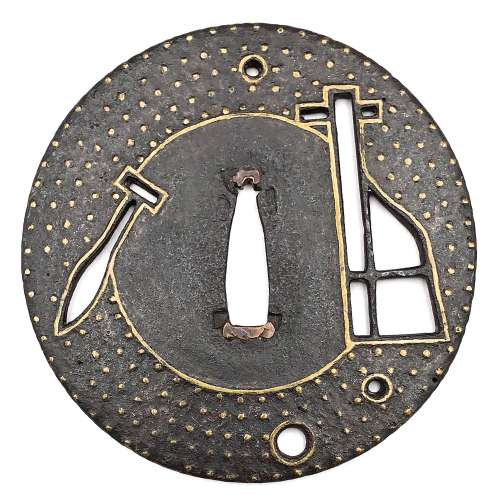
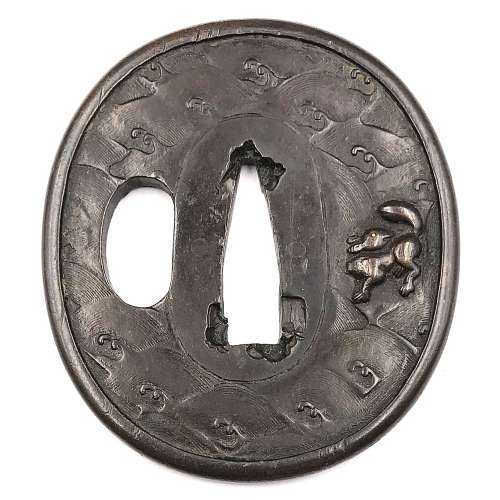
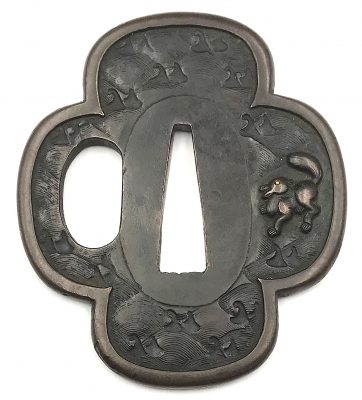
TSU-0282: Ko-kinko yamagane tsuba with waves and rabbit motif.
